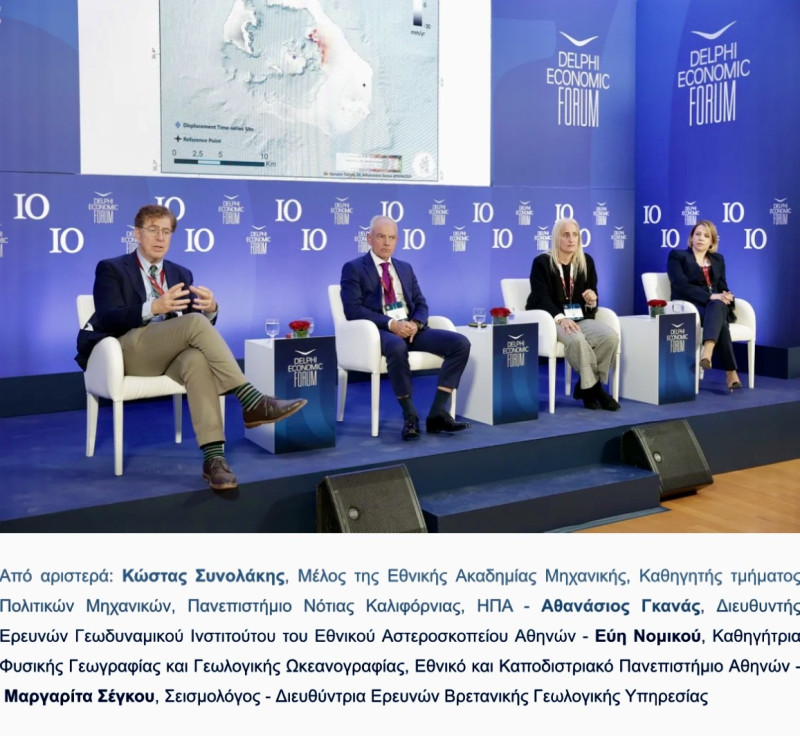The Delphi Economic Forum presented the first results of using artificial intelligence in surveillance of seismic activity
The first results for the use of high technology and artificial intelligence in monitoring of seismic activity in Santorini were presented at the 10th Delphi Economic Forum.
Speakers were Thanasis Ganas (National Observatory of Athens), Evi Nomikou (EKPA) and Margarita Segou (British Geological Service – BGS). The discussion was co -ordinated by academic Costas Synolakis, presenting historical data from the 1956 tsunami and possible scenarios of future earthquake or volcanic activity in the Mediterranean.
The Dr. Sego team in BGS used mechanical learning to record seismicity, identifying nearly 50,000 earthquakes, ten times more than traditional methods. This allowed the extremely accurate monitoring of the evolution of seismic episodes and understanding wicked processes in almost real time.
Dr. Sego stressed that years of research were required for such quality data, but artificial intelligence and computing clouds change data on seismology. Indeed, according to a retrospective analysis, the crisis seemed to start in November, that is, two months earlier than the start of the intense phase, which shows how useful the timely technological preparation is to inform the population and the authorities. The crisis evolves into four phases with pulses, with increasing duration, as shown in the diagram. The analysis indicates the existence of a wicked vein at a BA address, with a potential center under the anhydrous.
Professor Evi Law noted that real -time monitoring offers a critical reaction time, protecting communities and tourism activity. Seismic stimulation is associated with a magma penetration at a depth of 3-5 km below the anhydrous, causing tectonic tendencies and activation of cracks. The phenomenon will continue as long as the wicked chamber feeds.
In 2022, tourism in Santorini contributed 5.9 billion euros to Greek GDP. The Santory Marine Observatory, the first of its kind in Greece, contributes decisively to the scientific knowledge of processes in the submarine volcano with impressive results. It provides monitoring of natural parameters and is a role model for the Eastern Mediterranean, enhancing climate change adaptation and can provide necessary data for future development of risk management strategies for coastal areas.
Thanassis Ghana He presented the geodetic data and observed that as early as August 2024 they showed a gradual elevation of Caldera, which amounted to a total of 4 cm by the end of January 2025, when the distortion stopped and moved to the wider area of the islet.
GNSS data (ie 3D deformation measurements) from the Station of Anhydros showed a 12cm sedimentation within 2 weeks and parallel to west.
The simulation of the deformation showed the stimulation of the volcano in two phases: first the rise of a magma 8 million cubic meters in the Kammeni wicked chamber, then the magma headed northeast towards the anterior, utilizing a vein. The latest data in March shows that the deformity continues at a reduced rate in the eastern part of the caldera.
Kostas Synolakis recalled that the tsunami of 1956 reached up to 20 meters on land. Despite the severity of the danger, Greece has only 12 tidalists and no submarine seismograph connected to real time. He emphasized the need to create a volcanic observatory in the Santory -based submarine section, but it needs to be framed by reinforced terrestrial observation networks with high -precision analysis in real -time with the use of artificial intelligence for continuous monitoring of all Greek volcanoes, without relying on foreign volcanoes. As he said, we cannot depend on the goodness of foreign partners who lend us immense know -how and meters and that our volcanoes need 24/7 follow -up, not whenever the volcanoes themselves remind us. He also pointed out the need for meritocracy in appointments to scientific committees for reliable informing of the state in crises.
Finally, Dr. Sego stressed that the cost of failure in estimates is huge. According to Lloyd’s estimated, the explosion of one or some of the 16 most dangerous volcanoes in the world could cost up to 1.4 trillion. dollars in the world economy in five years after the explosion. For Greece, the damage from a volcanic explosion is estimated by the same source at 40 billion.
Source :Skai
I am Terrance Carlson, author at News Bulletin 247. I mostly cover technology news and I have been working in this field for a long time. I have a lot of experience and I am highly knowledgeable in this area. I am a very reliable source of information and I always make sure to provide accurate news to my readers.











